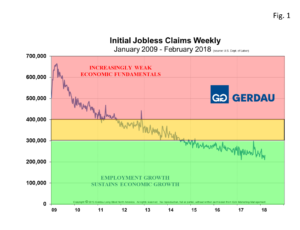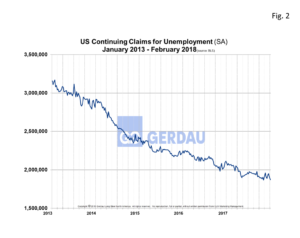Employment: Initial, Continuous Jobless Claims
February seasonally adjusted, (SA) initial claims for unemployment insurance rose by 21,000 to 231,000. Despite the increase the total remains near the lowest level in nearly 50 years. The non-seasonally adjusted, (NSA) four week moving average (4WMA) was 216,850, 7.9% lower than for the same period last year. Layoffs are low and hiring statistics continue to be impressive indeed.
Seasonally adjusted, continuous claims stood at 1.870 million, (M) as of February 24th, down 60,000 week on week, (w/w). The SA four week moving 4WMA was slightly higher at 1.906M, down 143,700 or 7.0% year on year, (y/y).
Unemployment insurance claims are a count of recipients by state of benefits mandated by federal law. Initial claims for unemployment benefits provide a proxy for layoffs, whereas continuing claims give a timely sense of the stock of unemployed workers.
 Figure 1, charts SA initial claims for unemployment insurance from 2009 to present. One would have to go all the way back to the early 1970s to find lower numbers. This small level of initial claims is indicative of a labor market that is in very good health.
Figure 1, charts SA initial claims for unemployment insurance from 2009 to present. One would have to go all the way back to the early 1970s to find lower numbers. This small level of initial claims is indicative of a labor market that is in very good health.
Figure 2 charts SA continuous claims for unemployment from 2013 to present. Continuous claims are at also at historic lows.
charts SA continuous claims for unemployment from 2013 to present. Continuous claims are at also at historic lows.
The insured unemployment rate was dell 0.1 to 1.3% in the week ended February 24th, it had been stuck-on 1.4% has been for several months. Just one state, Massachusetts reported an increase in NSA new filings in excess of 1,000 in the week ended February 24th. Seven states reported a decline in NSA new fillings greater than 1,000. California reported the highest number at 9,160 with layoffs predominately in the service industries.
The employment report from the Bureau of Labor Statistics, (BLS) reported that job creation in January totaled 200,000, beating analysts’ expectations. The ADP national employment report released yesterday indicated that private employment increased by 235,000 between January and February. The new BLS figures are expected tomorrow and we will issue a separate report on the new numbers at that time.
The labor participation was also unchanged, at 62.7%, as was the employment-to-population ratio, at 60.1%.
Thus far, 2018 is off to a terrific start for the labor market. Job openings continue at record high levels and the number of unemployed workers is now lower than the last expansion. The fact that there are many job openings and little movement in wage increases suggests that slack still remains in the labor market.
At Gerdau, we keep a keen eye on the employment numbers because we have demonstrated that there is an excellent correlation between employment levels and steel consumption. High job creation and low unemployment translate to strong steel demand and vice versa.

